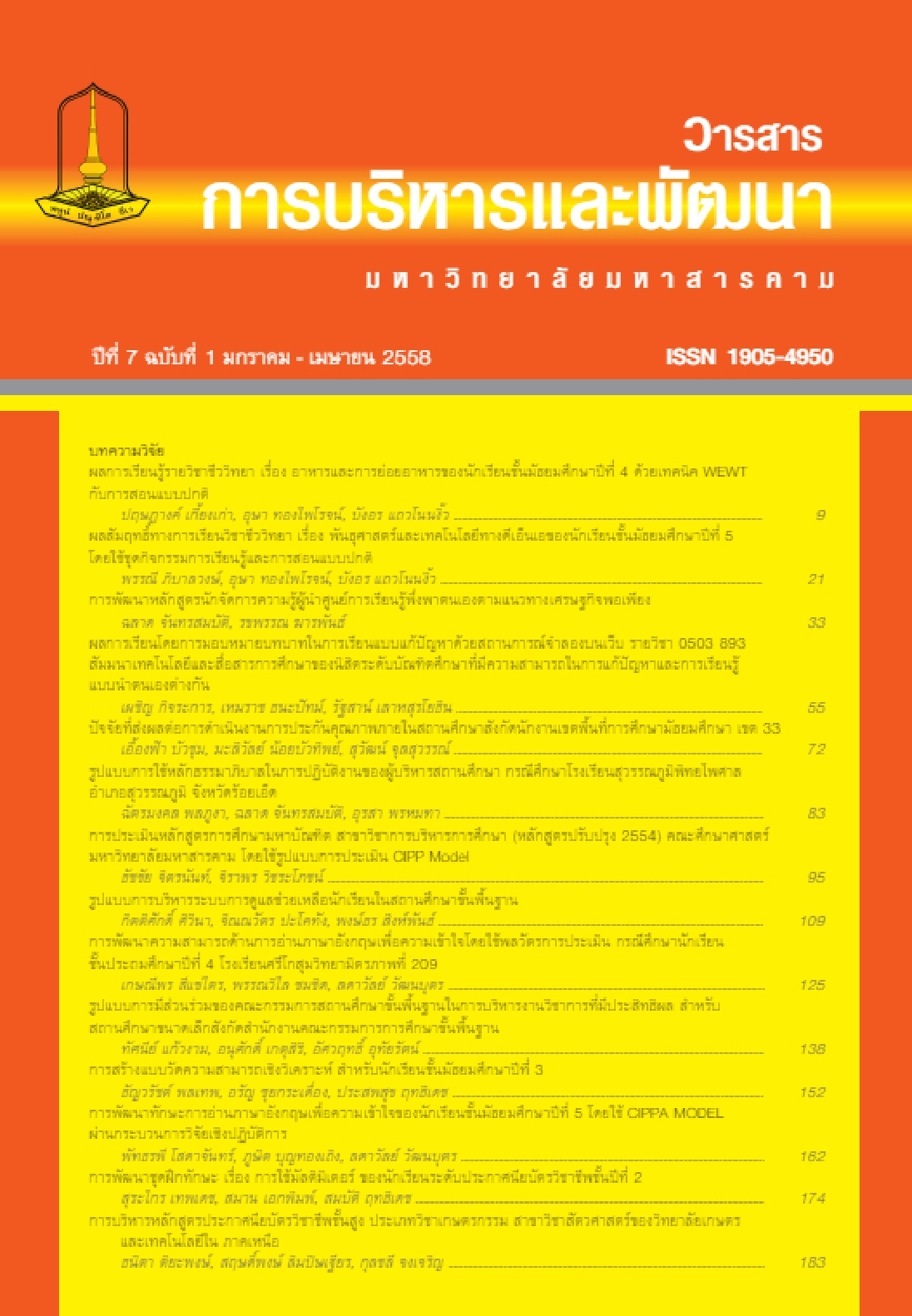The Administrative Model for Students Assistant Process in the School under the Primary Educational Service Area Office.
Main Article Content
Abstract
The general purpose of the research is to present student care system management model in schools. The specific purposes are 1) to study the present circumstances and the needs in student care system management in schools, 2) to construct a student care system management model in schools, 3) to evaluate a student care system management model in schools and 4) to present a student care system management model in schools. The research methodology consists of four steps. The first one is to study the present circumstances and needs in student care system management in schools. The 363 informants are school administrators, teachers who are responsible for a student care system and advisers. The research instrument used for collecting data is questionnaire. The data was statistically analyzed using mean and standard deviation. The second group of informants for the first step is three best practices schools. The data was collected by an observation and interview. The data was analyzed using content analysis. The second step is to construct a student care system management model and the manual for using the model. The informants of this step are 9 specialists. The data was collected by suitability evaluation form and possibility evaluation form and statistically analyzed using mean and standard deviation. The third step is to evaluate a student care system management model suitability and possibility. The informants are 17 specialists. The data was collected by suitability evaluation form, possibility evaluation form and usefulness evaluation form and was statistically analyzed using mean and standard deviation. The fourth step is to present a student care system management model. The informants are 21 specialists. The data was collected by focus group discussion and was analyzed using content analysis.
The research results are concluded that:
1. The overall image of operating conditions of a student care system management in schools is at high level. The problems found are coaching, supervision and following up. The need conditions are seriously and continuously student care system. 2. A student care system management model consists of seven main elements and minor elements. The first is 1) images of successful, 2) missions and 3) goals. The second is inputs which are 1) leadership of the school administrator,2) teachers’ good attitudes and capacity, 3) and media and innovation. The third is processes which are construction of 1) the setting up of system,2) the system operation, 3) the setting up of work system and school guidance activity,4) communities’ and parents’ cooperation,5) coaching, mentoring and evaluation and 6) supporting of a student care system. The fourth is products which contain 1) protection, 2) promoting life skills education, 4) adaptation ability,5) students’ all around abilities development. The fifth is evaluations which are 1) input evaluation, 2) process evaluation, and 3) product evaluation. The sixth is feedbacks and improvement which are 1) input improvement, 2) process improvement and 3) product improvement. The seventh is success conditions which are 1) school administrators and teachers are aware of students care system importance, 2) school administrators and teachers support and have good attitude toward students care system and 3) school associate fellows work together in order to provide knowledge and necessary skills that are useful for student care system. 3. The suitability evaluation, possibility evaluation and usefulness evaluation of a student care system management model in schools are rated overall at the highest level. 4. The presentation of a student care system management model in schools to the specialists was released that the structure of the model are suitable and well organized. The model has presented the relations of major and minor elements. Moreover, the model also consists of feedback system and chart in order to enhance clearly understanding and efficiency implementation.
Downloads
Article Details
References
Auychai Sritrakul. (2012). The Development of Student Care System Management Model in School under the Primary Educational Service Area Office. Master of Education Thesis in Educational Administration, Naresuan University.
Derek Wannasian. (2002). The Development of Comprehensive School-base Management Model for Basic Education Institutions. Doctoral of Education Thesis in Educational Administration, Graduate School Chulalongkorn University. National Education standard and Quality Assessment (Public Organization).
Office. (2004). National Education Act B.E. 2542 (1999) as amended by Act (No.2), B.E. 254 (2002). Bangkok: Prigwan Graphics.
Praewpan Sunanta. (2009). Development of Student Assistant System in Secondary Education Extension School under the Office of Chaing Rai Educational Service Area. Master of Education Thesis in Educational Administration, Graduate School, Chaing Rai Rajabhat University.
Kast, Fremont E. and James E. Rosenzweig. (1988). Organization and Management: ASystem and Contingency Approach. 4th ed. New York: McGraw – Hill.
Sirichai Karnchanawasri et al. (2007). Operating Model of Integrated Educational Management System of Educational Service Areas. Changes via Education for enteringKnowledge Based Economic Age Integrated Research Project. Chulalongkorn University.
Sombat Thamrongthanyawong. (2006). Thai Politics and Government: Dictator Period – Revolution Period. 2nd ed. Bangkok: Sematham.
Thana Sunthrayuth. (2008). Transformational Management: Theory, Research and Practice in Education. Bangkok: Netikoolkarnpim.
Uthai Boonprasert. (2000). The Study of Administrative and Educational Management using School - Based Management. Bangkok: Kurusapha Ladprao Publisher.


